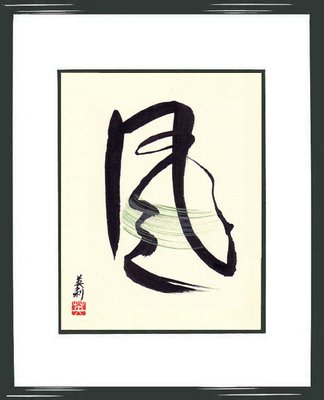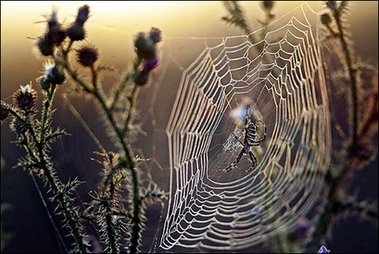
風林火山
Wind-Forest-Fire-Mountain
These characters adorned the war banners of Takeda Shingen, the Tiger of Kai, in 16th century Japan. The four characters represent his motto:
Swift as the Wind
Silent as the Forest
Fierce as Fire
Immovable as a Mountain
Below is the Wikipedia article on Shingen. If you click on the title of this post, you'll be directed to that page, where you'll find more links, etc.
Takeda Shingen (武田信玄, Takeda Shingen
?)(
December 1,
1521 –
May 13,
1573) of
Shinano and
Kai Provinces, was a preeminent
daimyo who fought for control of
Japan during that country's
Sengoku or "warring states" period.]
Note on the name
Takeda Shingen was born under the name of "Takeda Katsuchiyo". He took the name of "Takeda Harunobu" at his coming of age ceremony, and in the year of 1551 changed his name once again, this time to the well-known "Takeda Shingen". This article will note such name changes, but will primarily be using the name of "Takeda Shingen" to help avoid any confusion on the issue.
Shingen is sometimes referred to as "The Tiger of Kai" (
Kai being the Takeda home province) due to his fearsome martial art skills on the battlefield. His rival,
Uesugi Kenshin, was often called "The Dragon of
Echigo". Shingen and Kenshin had always been interested in Chinese culture, especially the works of
Sun Tzu; in
Chinese mythology, the Dragon and Tiger have always been bitter rivals who try to defeat one another, but they always fight to a draw.
Life
Born Takeda Katsuchiyo, he was the eldest son of
Takeda Nobutora, an impressive warlord. He helped his father in many of the older Takeda's undertakings, and became quite valuable in the clan at a fairly young age. However, at some point in his life following his "coming of age" ceremony (where he changed his name to Takeda Harunobu) the young man rebelled against his father and took control of the Takeda clan. The events surrounding this change of leadership are not entirely clear, but it is speculated for the most part that his father had planned to name the second son,
Takeda Nobushige, as his heir instead of Shingen. However, regardless of the reasons, the end result was the father being forcibly retired from his position (though it is not believed he was killed or forced to commit
seppuku, as this event has been cited as a "bloodless coup") and Shingen taking control of the Takeda.
Imagawa Yoshimoto helped him in this rebellion and an alliance was formed between the
Imagawa and
Takeda families.]
Initial Expansion
Shingen's first act was to gain a hold of the area around him. His goal was to conquer
Shinano Province. A number of the major daimyos in the Shinano region marched on the border of Kai, hoping to neutralize the still-young Shingen's power before he had a chance to expand into their lands. However, planning to beat him down at Fuchu (where word had it Shingen was gathering his forces for a stand), they were unprepared when Takeda forces suddenly came down upon them at
Sezawa. Taking advantage of their confusion, Shingen was able to score a quick victory, which set the stage for his drive into Shinano lands that same year. The young warlord made considerable advances into the region, conquering the Suwa headquarters of
Kuwabara before moving into central Shinano with the defeat of both
Tozawa Yorichika and
Takato Yoritsugu. However, the warlord was checked at Uehara by
Murakami Yoshikiyo, losing two of his generals in a heated battle in which Murakami came out on top. Shingen managed to avenge this loss and the Murakami clan was eventually defeated. Murakami fled the region, eventually coming to plead help from the
Uesugi clan.
After he had conquered Shinano, Shingen (who had changed his name to this in 1551) faced another rival -
Uesugi Kenshin of Echigo. The feud between these two became almost legendary, and they faced each other on the battlefield a total of five times at
Kawanakajima (years: 1554, 1555, 1557, 1561, 1564). These "battles" were generally confined to controlled skirmishes, neither daimyo willing to devote themselves entirely to a single all-out attempt. The one conflict between the two that had the fiercest fighting, and might have decided victory or defeat for one side or the other, was the fourth such battle. It was in this fourth contest that the famous tale was formed of
Uesugi Kenshin's forces clearing a path through the Takeda troops and Kenshin engaging Shingen in single combat. The tale has Kenshin attacking Shingen with his sword while Shingen defends with his iron war fan or
gunpai. Both lords lost a considerable number of men in this fight, and Shingen in particular was deprived of two of his main generals,
Yamamoto Kansuke and his younger brother
Takeda Nobushige.]
Pause in Growth
Around this time period, the Takeda clan suffered two setbacks within the group itself. Shingen uncovered two plots on his life, the first from his cousin
Katanuma Nobumoto (whom he ordered to commit seppuku), and the second, a few years later, from his own son
Takeda Yoshinobu. His son was confined to the Tokoji, where he died two years later. It is uncertain as to whether his death was natural or ordered by his father. This left Takeda Shingen, for the moment, without an heir. However, he later had more sons, and it was actually his fourth who would take control of the Takeda clan after his death.
By 1564, after he had completely defeated the Shinano region and taken a number of castles from his rival the
Uesugi clan, Shingen kept his realm fairly contained, contenting himself to a number of small raids and mostly internal affairs. During this time he ordered the damming project of the
Fuji River, which was one of the major domestic activities of the time.]
Renewed Expansion
After
Imagawa Yoshimoto (a former ally of the Takeda) was killed by
Oda Nobunaga, Shingen made a move against the weak Imagawa under the incompetent leadership of Yoshimoto's son,
Imagawa Ujizane. A pact is believed to have been formed between Shingen and
Tokugawa Ieyasu for control of the remaining Imagawa lands, and they both fought against Yoshimoto's heir. However, the agreement between the Takeda and Tokugawa forces quickly fell through, and after the Imagawa were no longer an issue, Shingen made a move against Ieyasu.]
Final Conflict
The future of all of Japan was now in the balance, as Takeda Shingen, at 49 years of age, was the one daimyo with the power, position, and skill necessary to stop
Oda Nobunaga's headlong rush to ruling the land of Japan. He engaged Tokugawa forces in 1572 and captured
Futamata, and then stepped forward once again in January at Mikata-ga-hara. At
Mikata-ga-hara, Takeda Shingen easily defeated the combined armies of
Oda Nobunaga and
Tokugawa Ieyasu; but he could not defeat old age. After defeating
Tokugawa Ieyasu, Shingen actually checked his forward momentum for a small time due to outside influences, and Ieyasu was given a brief reprieve. Surprisingly, as he started pressing forward once again in 1573, Takeda Shingen died (scholars are divided as to whether this was due to illness or a festering wound from a sniper).]
After Death
Takeda Katsuyori took control of the Takeda. Katsuyori was ambitious and desired to continue the legacy of his father. He moved on to take Tokugawa forts. However an allied force of Tokugawa Ieyasu and Oda Nobunaga dealt a crushing blow to the Takeda in the
Battle of Nagashino. Here Oda Nobunaga's gunmen destroyed the Takeda cavalry. Ieyasu seized the opportunity and defeated the weak Takeda led by
Takeda Katsuyori in the battle of
Tenmokuzan. Katsuyori committed suicide after the battle, and the Takeda clan would never recover.
Upon Shingen's death, Kenshin reportedly cried at the loss of one of his strongest and most deeply respected rivals. Perhaps one of the most lasting tributes to Shingen's prowess, however, was
Tokugawa Ieyasu himself, who is known to have later borrowed heavily from the old Takeda leader's governmental and military innovations after he had taken leadership of Kai during
Toyotomi Hideyoshi's rise to power. Many of these designs were put to use in the
Tokugawa Shogunate.
The Takeda were for the most part utterly destroyed by the loss of Shingen's heir, Katsuyori. However Shingen had had a profound effect on the period in Japan. He influenced many lords with his law system, tax system and administration system. He was probably not as cruel as other warlords, but he was aggressive toward military enemies. There were many tales about Takeda Shingen including the one mentioned above. His war banner contained the famous phrase Fuu-Rin-Ka-Zan(風林火山), taken from
Sun Tzu's '
The Art of War.' This phrase refers to the idea of Swift as the Wind, Silent as a Forest, Fierce as Fire and Immovable as a Mountain.
The phrase demonstrates both Shingen's policies and warfare strategy.]
Retainers
During
Edo period, 24 retainers who served under Shingen were chosen as a popular topic for
Ukiyo-e and
Bunraku. The names vary from work to work and the following list is the widely agreed version of retainers. They had not worked together as some had died before others served but they were noted for their exceptional contributions to Shingen and the
Takeda family.
Of his retainers,
Kōsaka Masanobu stands out as being one of Shingen's better known beloveds, in the style of the Japanese
shudo tradition. The two entered into the relationship when Shingen was twenty two and Masanobu sixteen. The love pact signed by the two, in Tokyo University's Historical Archive, documents Shingen's pledge that he was not, nor had any intentions of entering into, a sexual relationship with a certain other retainer, and asserts that "since I want to be intimate with you" he will in no way harm the boy, and calls upon the gods to be his guarantors. (Leupp, pp.53-54)
Takeda Nobushige
Takeda Nobukado
Ichijo Nobutatsu
Itagaki Nobukata
Amari Torayasu
Yokota Takatoshi
Obu Toramasa
Hara Toratane
Obata Toramori
Obata Masamori
Yamamoto Haruyuki
Tada Mitsuyori
Yamagata Masakage
Baba Nobuharu
Naito Masatoyo
Kōsaka Masanobu
Sanada Yukitaka
Sanada Nobutsuna
Anayama Nobukimi
Oyamada Nobushige
Akiyama Nobutomo
Hara Masatane
Saegusa Moritomo
Tsuchiya Masatsugu
Sanada Yukimura
[
edit]
Takeda Shingen in fiction and drama
The 1988
NHK Taiga drama television series Takeda Shingen was a fictionalized account of his life with
Nakai Kiichi in the title role.
Akira Kurosawa's
1980 movie
Kagemusha was also inspired by his life; it brought the musket-wound theory to public attention outside Japan.
Takeda Shingen appears in
Toshiro Mifune's historical movie
Samurai Banners (風林火山 Furin Kazan). The film is a depiction of the life of Shingen advisor
Yamamoto Kansuke from
1545-
1562. In this movie it is suggested that it was Kansuke's idea for Shingen to marry Lady Biwa.
Takeda Shingen appears in the epic film
Heaven and Earth (not to be confused with
Oliver Stone's
Vietnam war drama), seen from Uesugi Kenshin's point of view. The movie is mainly about the fourth battle of Kawanakajima.
In the
Japanese science-fiction movie
Sengoku Jieitai, in English also known as Time Slip and G.I. Samurai (
1979), a group of Japanese Defese Force soldiers, who are stranded in the 16th century by a freak timeshift, take on his forces. Takeda Shingen is subsequently killed in a duel with the soldiers' leader, Lieutenant Iba (performed by
Sonny Chiba).
Takeda Shingen is the main character in the
NES game
Shingen the Ruler, and his conquests are also portrayed in the PC game,
Takeda.
Shingen also appears as a character in the
Samurai Warriors game series for the
PlayStation 2. It is notable that in this game, Shingen's weapon is a large war fan, probably taken from accounts of the fourth battle of
Kawanakajima.
Takeda Shingen also appears, although briefly, in
Kessen 3. His depiction is as somewhat overconfident, but as a great warrior and strategist, well respected by his officers and foes alike. He is one of the few enemies one faces in the game who is not shown as a tyrant or a fool. His son, however, is shown as a stubborn and hotheaded warrior who tramples over his father's dying advice, and pays dearly for it.
Takeda Shingen appears many times as a playable Daimyo in
Nobunaga's Ambition (信長の野望 Nobunaga no Yabo) video game series. The game is a strategy simulation in which Shingen character attribute "Intelligence" and "Politic" skills are quite high, while Kenshin "War" skill is slightly higher than Shingen.
The Takeda Clan also appears as one of the many warring clans in the game
Shogun: Total War, the first of the four games in the Total War series. Players may choose to take command of this clan (or any other clan) and fight against other clans for the title of Shogun and the right to rule all of Japan.
Takeda Shingen is a playable character in
Sengoku Basara. His depiction is a somewhat huge warrior wielding a huge, flaming axe resembling his war fan. In
Devil Kings he is renamed as Red Minotaur.
In the Street Fighter series,
Ansatsuken fighters
Ryu and
Ken Masters have the Japanese Kanji Fuurinkazan on their belts. In Ryu's stage on Street Fighter II, there were breakable signs with the aforementioned slogan on them on both ends of the stage.]
External links
Samurai Archives- Takeda Shingen
SengokuDaimyo.com The website of Samurai Author and Historian
Anthony J. Bryant
The website of Takeda family martial arts
[
edit]
The festival in Japan
The Takeda Shingen festival takes place in
Kofu across the first weekend every April. Usually a famous Japanese TV actor is hired to play the part of Takeda Shingen himself. There are several parades going to and from the
Takeda Shrine and
Kofu Castle. These parades are very theatrical involving serious re-enactors who practice over the course of the rest of the year for this one weekend in April. The parades reflect the different comings and goings of Takeda Shingen during his life.






















